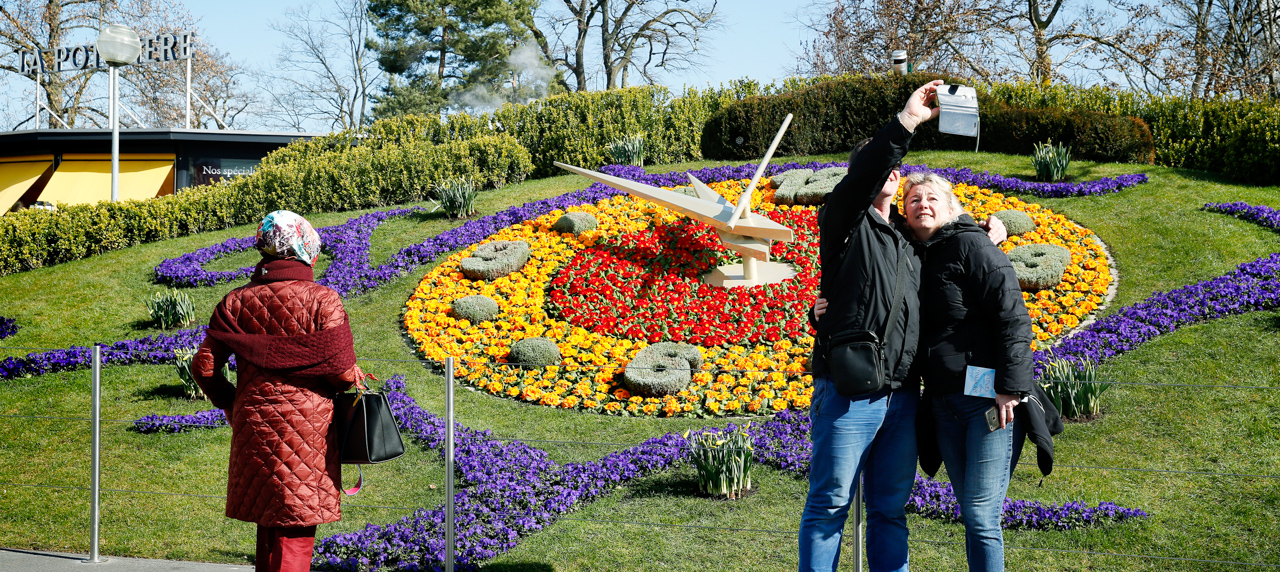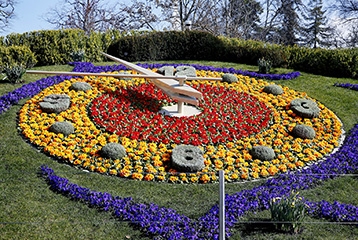As emblematic of the city as the Jet d’eau and snapped by the cameras of the numerous tourists, the horloge fleurie is a perfect combination of clockmaking know-how and horticultural skill.
Related article
A new floral concept consisting of more than 3000 plants was meticulously installed by the carpet-breeding experts of the City of Geneva’s Parks and Gardens Department. The installation includes a watering system, essential to the survival of the plants as they are fully exposed to the sun.
New hands, boasting an elegant design similar to the original ones, were made and generously offered to the City by the company Patek Philippe. The 2.5-metre-long second hand is doubtless the largest in the world. The time is set electronically by satellite.
Four floral decorations every year
To ensure that the plants flower in accordance with each season, the clock’s floral decoration is renewed four times a year:
- Summer: planting of alternantheras and begonias;
- Autumn-Winter: planting of pansies;
- March: planting of primroses;
- April to mid-May: planting of pansies.
Acces
The Horloge fleurie est accessible by public transports:
- lines 25, 10, 9, 8, 7, 6, 2, Métropole stop;
- lines 36, 17, 10, 9, 7, 6, 2, Molard stop;
- Mouettes Genevoises, Molard stop.
History and development
The horloge fleurie was created in 1955 by the Parks and Promenades Department, at the initiative of the Association des intérêts de Genève. The mastermind behind it was the landscape architect, Armand Auberson (the father of the rose garden in Parc La Grange created 10 years earlier). Several generations of gardeners specialising in carpet bedding have come and gone since the creation of the clock, planting and tending to the thousands of flowers and plants that make up this arrangement.
A reference point around the globe, the horloge fleurie has been modified a number of times. In 1992, to ensure greater safety for the growing number of tourists keen to take a photograph of themselves in front of it, it was moved 8 metres towards the interior of the park.
With the last renovation in 2017, an integrated watering system was installed together with new clock hands, made as a gift to the City by Patek Philippe. The elegant design is similar to that of the original. The 2.5-metre-long second hand is doubtless the largest in the world. The time is set electronically by satellite.
Ecological management
The thousands of plants and flowers comprising the clock are maintained by entirely natural means without the use of any phytosanitary products. In summer, to avoid disease, fungi and other threats, the traditional ornamental plants are replaced by succulent plants. Accustomed to arid climates, these plants store liquids and nutrients (the Latin succulentus means full of juice).
Maintenance
A symbol of green Geneva, the site is monitored closely by the specialist gardeners of the City’s Parks and Gardens Service, who work on it every week. All the plants comprising the horloge fleurie are produced in the City’s horticultural production centre and bear the label “Genève Région - Terre avenir”.
Accessibility of the site
Accessible en fauteuil roulant
Article modifié le 22.09.2023 à 10:13


